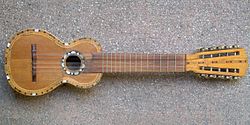 A modern charango | |
| String instrument | |
|---|---|
| Other names | Quirquincho, Mulita, Tatu, Kirki |
| Hornbostel–Sachs classification | 321.321-5 (Composite chordophone sounded by the bare fingers) |
| Developed | Early 18th century (perhaps earlier) |
| Playing range | |
|
E4 - (G6)
Charango tuning (Am7/E) | |
| Related instruments | |
| Walaycho; Chillador; Ronroco; et al (see text). Concheras (also has armadillo back) | |
The charango is a small Andean stringed instrument of the lute family, from the Quechua and Aymara populations in the territory of the Altiplano in post-Colonial times, after European stringed instruments were introduced by the Spanish during colonialization. The instrument is widespread throughout the Andean regions of Bolivia, Peru, Ecuador, northern Chile and northwestern Argentina, where it is a popular musical instrument that exists in many variant forms.[1]
About 66 cm (26 in) long, the charango was traditionally made with the shell from the back of an armadillo (called quirquincho or mulita in South American Spanish),[2][3] but it can also be made of wood, which some believe to be a better resonator. Wood is more commonly used in modern instruments.[2] Charangos for children may also be made from calabash.[3] Many contemporary charangos are now made with different types of wood. It typically has ten strings in five courses of two strings each, but many other variations exist.
The charango was primarily played in traditional Andean music. A charango player is called a charanguista.
- ^ "ORIGEN DEL CHARANGO". charango.cl. Archived from the original on 2015-01-07. Retrieved 2014-10-16.
- ^ a b "Todo acerca del Charango". charango.cl. Archived from the original on 2014-09-22. Retrieved 2014-10-16.
- ^ a b "Familia de los charangos". jlfeijooi.en.eresmas.com. Archived from the original on 2006-04-26. Retrieved 2014-10-16.
